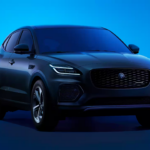When you’re researching a performance automobile, one of the things you’ll naturally pay close attention to is the horsepower delivered by its engine. Simply defined, one horsepower is enough to move a 550 pound object one foot in one second. Figuring out how much horsepower is “enough” depends on your vehicle’s gross vehicle weight (curb weight* plus the average weight of whatever it will be carrying). Taking a fully-loaded 2016 Jaguar XJ as our baseline (4,156 pound curb weight, and let’s tack on another 175 pounds for the driver), an eight-horsepower motor — about the size you’d find on an outboard motorboat — would move you a leisurely one foot per second, or just under one mile per hour.
It would, in other words, be faster (and much less fun) to walk. So we opt for higher horsepower to accelerate, and get there, faster. Thankfully, the Jaguar XJ R SPORT has a 340 hp V6 engine, so don’t reach for your sneakers just yet. But you’ll also need to consider torque. After all, the power generated by an engine is only half of the equation. Torque is the other half. It’s a measure of twisting force, expressed in pound feet (lb ft.). What’s being twisted, in this case, is your car’s wheels. Put simply, if the torque number is too low in relation to the vehicle’s horsepower, your vehicle is letting a lot of that power go to waste.
There’s something else to consider. Sometimes a bit less horsepower can actually be a good thing. When higher horsepower means opting for an eight-cylinder engine over one with six cylinders, you’re scaling up the vehicle’s overall mass in the name of more power. There are times when the lighter weight offered by the smaller engine offsets the lower horsepower and offers better handling characteristics besides. Think of it this way: an extra hundred horsepower doesn’t mean much if you’re sacrificing agility.
Of course, some of this is highly subjective. The torque and horsepower numbers on a Jaguar are only part of a much bigger picture. Some people prioritize a car that’s quick off the line, some prefer nimble handling, while others don’t care as much for speed and prefer a luxuruious and refined ride. Numbers and research only get you so far, however; these are Jaguar cars, not pocket calculators.
The solution, therefore, is to take a test drive. Try multiple models and trim levels, since a 2016 Jaguar XJ is going to give you a much different experience than a 2017 Jaguar F-TYPE, while the power train options (to say nothing of other important features) among trim levels can be very different. To schedule that test drive, call or come to Jaguar of Peabody in Peabody, MA today.
*Curb weight is the weight of your vehicle with all its fuel and fluids, minus occupants and cargo.





